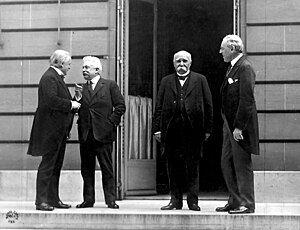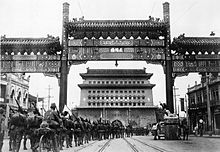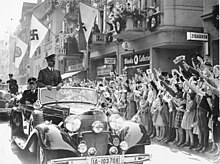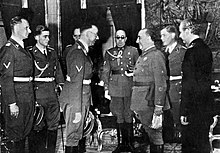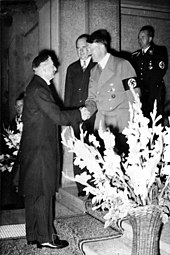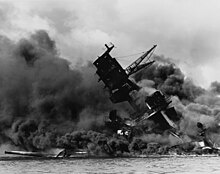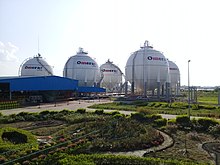The German battleship Schleswig-Holstein attacked Westerplatte at the start of the war, September 1, 1939
Destroyer USS Shaw exploding during the attack on Pearl Harbor, December 7, 1941
Historians from many countries have given considerable attention to studying and understanding the causes of World War II, a global war from 1939 to 1945 that was the deadliest conflict in human history. The immediate precipitating event was the invasion of Poland by Nazi Germany on September 1, 1939, and the subsequent declarations of war on Germany made by Britain and France,
but many other prior events have been suggested as ultimate causes.
Primary themes in historical analysis of the war's origins include the
political takeover of Germany in 1933 by Adolf Hitler and the Nazi Party; Japanese militarism against China; Italian aggression against Ethiopia; and Germany's initial success in negotiating a neutrality pact with the Soviet Union to divide territorial control of Eastern Europe between them.
During the interwar period, deep anger arose in Weimar Germany regarding the conditions of the 1919 Treaty of Versailles, which punished Germany for its role in the First World War with severe conditions and heavy financial reparations in order to prevent it from ever becoming a military power again. This provoked strong currents of revanchism in German politics, with complaints primarily focused on the demilitarization of the Rhineland, the prohibition of German unification with Austria, and the loss of some German-speaking territories and overseas colonies.
The 1930s were a decade in which democracy was in disrepute;
countries across the world turned to authoritarian regimes during the
worldwide economic crisis of the Great Depression.
In Germany, resentment and hatred of other countries was intensified by
the instability of the German political system, as many activists
rejected the legitimacy of the Weimar Republic. The most extreme
political aspirant to emerge from this situation was Adolf Hitler, leader of the Nazi Party. The Nazis took totalitarian power in Germany
beginning in 1933 and demanded the undoing of the Versailles
provisions. Their ambitious and aggressive domestic and foreign policies
reflected the Nazi ideologies of anti-Semitism, unification of all Germans, the acquisition of "living space" (Lebensraum) for agrarian settlers, the elimination of Bolshevism, and the hegemony of an "Aryan"/"Nordic" master race over "sub-humans" (Untermenschen) such as Jews and Slavs. Other factors leading to the war included aggression by Fascist Italy against Ethiopia and Albania, and by Imperial Japan against much of East Asia, resulting in the invasion of Manchuria in 1931 and the gradual annexation of most of China.
At first, these aggressive moves met with only feeble and ineffectual policies of appeasement from the other major world powers. The League of Nations, established after the First World War, proved helpless regarding China and Ethiopia. A decisive proximate event was the 1938 Munich Conference, which formally approved Germany's annexation of the Sudetenland
from Czechoslovakia. Hitler promised it was his last territorial claim,
but in early 1939 he became even more aggressive, and European
governments finally realized that appeasement was not guaranteeing
peace. Britain and France badly fumbled diplomatic efforts to form a
military alliance with the Soviet Union, and Hitler instead offered
Stalin a better deal in the Molotov–Ribbentrop Pact of August 1939. An alliance formed by Germany, Japan, and Italy led to the establishment of the Axis Powers.
Ultimate causes
Legacies of the First World War
"The Big Four" made all the major decisions at the Paris Peace Conference (from left to right, David Lloyd George of Britain, Vittorio Emanuele Orlando of Italy, Georges Clemenceau of France, Woodrow Wilson of the U.S.)
By the end of World War I in late 1918, the world's social and geopolitical circumstances had fundamentally and irrevocably changed. The Allies
had been victorious, but many of Europe's economies and infrastructures
were devastated, including those of the victors. France, along with the
other victor countries, was in a desperate situation regarding its
economy, security, and morale, and understood that its position in 1918
was "artificial and transitory". Thus, Prime Minister of France Georges Clemenceau worked to gain French security via the Treaty of Versailles, and French security demands, such as reparations, coal payments, and a demilitarized Rhineland, took precedence at the Paris Peace Conference of 1919–1920,
which designed the treaty. The war "must be someone's fault – and
that's a very natural human reaction" analyzed historian Margaret
MacMillan. Germany was charged with the sole responsibility of starting World War I, and the "War Guilt Clause"
was the first step towards a satisfying revenge for the victor
countries, namely France, against Germany. Ginsberg argues, "France was
greatly weakened and, in its weakness and fear of a resurgent Germany,
sought to isolate and punish Germany....French revenge would come back
to haunt France during the Nazi invasion and occupation twenty years
later."
Germany after Versailles
Administered by the League of Nations
Annexed or transferred to neighboring countries by the treaty, or later via plebiscite and League of Nation action
The two main provisions of the French security agenda were war reparations from Germany in the form of money and coal and a detached German Rhineland.
The French government printed excess currency, which created inflation,
to compensate for the lack of funds, in addition to borrowing money
from the United States. Reparations from Germany were necessary to
stabilize the French economy.
France also demanded that Germany give France its coal supply from the
Ruhr to compensate for the destruction of French coal mines during the
war. The French demanded an amount of coal that was a "technical
impossibility" for the Germans to pay back. France also insisted on the demilitarization
of the German Rhineland in the hope of hindering any possibility of a
future German attack. This gave France a physical security barrier
between itself and Germany.
The inordinate amount of reparations, coal payments, and the principle
of a demilitarized Rhineland were largely viewed by the Germans as
insulting and unreasonable.
The resulting Treaty of Versailles
brought a formal end to the war but was criticized by governments on
all sides of the conflict: it was neither lenient enough to appease Germany, nor harsh enough to prevent it from becoming a dominant continental power again. The German people largely viewed the treaty as placing the blame, or "war guilt", on Germany and Austria-Hungary
and punishing them for their "responsibility", rather than working out
an agreement that would assure long-term peace. The treaty imposed harsh
monetary reparations as well as demilitarization requirements and territorial dismemberment, and caused mass ethnic resettlement, separating millions of ethnic Germans into neighboring countries.
In the effort to pay war reparations to Britain and France, the Weimar Republic printed trillions of marks, causing extremely high inflation. "No postwar German government believed it could accept such a burden on future generations and survive ...".
Paying reparations to the victorious side was a traditional punishment
with a long history of use, but in this instance it was the "extreme
immoderation" that caused German resentment. Germany did not make its
last World War I reparation payment until 3 October 2010,
ninety-two years after the end of the war. Germany also fell behind in
their coal payments because of a passive resistance movement against the
French.
In response, the French invaded the Ruhr and occupied it. By this point
the majority of Germans were enraged with the French and placed the
blame for their humiliation on the Weimar Republic. Adolf Hitler, a
leader of the Nazi Party, attempted a coup d'état of the Republic in
1923 known as the Beer Hall Putsch, through which he intended to establish a Greater German Reich. Although this failed, Hitler gained recognition as a national hero among the German population.
During the war, German colonies outside Europe had been annexed by the Allies, and Italy took the southern half of Tyrol after an armistice was agreed upon. The war in the east ended with the defeat and collapse of the Russian Empire, and German troops had occupied large parts of Eastern and Central Europe (with varying degrees of control), establishing various client states such as a kingdom of Poland and the United Baltic Duchy. After the destructive and indecisive Battle of Jutland in 1916 and the mutiny of its sailors in 1917, the Kaiserliche Marine
spent most of the war in port, only to be turned over to the Allies and
scuttled at surrender by its own officers. Decades later, the lack of
an obvious military defeat would be one of the pillars holding together
the Dolchstosslegende ("Stab-in-the-back myth"), giving the Nazis another propaganda tool.
The demilitarized Rhineland
and additional cutbacks on military also infuriated the Germans.
Although it is logical that France would want the Rhineland to be a
neutral zone, the fact that France had the power to make that desire
happen merely exacerbated German resentment of the French. In addition,
the Treaty of Versailles dissolved the German general staff, and
possession of navy ships, aircraft, poison gas, tanks, and heavy
artillery was made illegal.
The humiliation of being bossed around by the victor countries,
especially France, and being stripped of their prized military made the
Germans resent the Weimar Republic and idolize anyone who stood up to
it. Austria also found the treaty unjust, which encouraged Hitler's popularity.
These conditions generated bitter resentment towards the war's
victors, who had promised the people of Germany that U.S. President Woodrow Wilson's Fourteen Points
would be a guideline for peace; however, the United States played only a
minor role in World War I and Wilson could not convince the Allies to
agree to adopt his Fourteen Points. Many Germans felt that the German
government had agreed to an armistice based on this understanding, while others felt that the German Revolution of 1918–1919
had been orchestrated by the "November criminals" who later assumed
office in the new Weimar Republic. The Japanese also started to express
resentment against the countries of Western Europe due to the way they
were treated during the negotiations of the Treaty of Versailles; their
proposition to start bringing the issue of the current racial equality
was not put in the final draft and was hardly talked about at the table
with nothing given in reward for Japanese participation in the war. The economic and psychological legacies of the First World War persisted well into the interwar period.
Failure of the League of Nations
The League of Nations was an international peacekeeping organization founded after World War I with the explicit goal of preventing future wars. The League's methods included disarmament, collective security,
settling disputes between countries through negotiation diplomacy, and
improving global welfare. The diplomatic philosophy behind the League
represented a fundamental shift in thought from the preceding century.
The old philosophy of "concert of nations", growing out of the Congress of Vienna (1815), saw Europe as a shifting map of alliances among nation-states, creating a balance of power
maintained by strong armies and secret agreements. Under the new
philosophy, the League would act as a government of governments, with
the role of settling disputes between individual nations in an open and
legalist forum. Despite President of the United States Woodrow Wilson
being the League's chief architect, the United States never joined the
League of Nations, which lessened its power and credibility—the addition
of a burgeoning industrial and military world power such as the United
States might have added more force behind the League's demands and
requests.
The official opening of the League of Nations, 15 November 1920
The League lacked an armed force of its own and so depended on member
nations to enforce its resolutions, uphold economic sanctions that the
League ordered, or provide an army when needed for the League to use.
However, individual governments were often very reluctant to do so.
After numerous notable successes and some early failures in the 1920s,
the League ultimately proved incapable of preventing aggression by the Axis Powers
in the 1930s. The reliance upon unanimous decisions, the lack of an
independent body of armed forces, and the continued self-interest of its
leading members meant that this failure was arguably inevitable.
Expansionism and militarism
Expansionism
is the doctrine of expanding the territorial base (or economic
influence) of a country, usually by means of military aggression. Militarism is the principle or policy of maintaining a strong military
capability to use aggressively to expand national interests and/or
values, with the view that military efficiency is the supreme ideal of a
state.
Though the Treaty of Versailles and the League of Nations had sought to stifle expansionist and militarist policies by all actors, the conditions their creators had imposed on the world's new geopolitical situation and the technological circumstances of the era only emboldened the re-emergence of these ideologies during the interwar period. By the early 1930s, a highly militaristic and aggressive national ideology prevailed in Germany, Japan, and Italy. This attitude fueled advancements in military technology, subversive propaganda, and ultimately territorial expansion as well. It is has been observed that the leaders of countries that have been suddenly militarized often feel a need to prove that their armies are formidable, and this was often a contributing factor in the start of conflicts in the interwar period such as the Second Italo-Abyssinian War and the Second Sino-Japanese War.
In Italy, Benito Mussolini sought to create a New Roman Empire based around the Mediterranean. It invaded Ethiopia as early as 1935, Albania in early 1938, and later invaded Greece. This provoked angry words and an oil embargo from the League of Nations, which failed.
Under the Nazi regime, Germany began its own program of
expansion, seeking to restore the "rightful" boundaries of historic
Germany. As a prelude toward these goals the Rhineland was remilitarized in March 1936. Also of importance was the idea of a Greater Germany, supporters of which hoped to unite the German people
under one nation state, which included all territories where Germans
lived, regardless of whether they happened to be a minority in a
particular territory. After the Treaty of Versailles, a unification
between Germany and a newly formed German-Austria, a successor rump state of Austria-Hungary, was prohibited by the Allies despite the majority of Austrian Germans supporting such a union.
During the period of the Weimar Republic (1919–1933), the Kapp Putsch, an attempted coup d'état
against the republican government, was launched by disaffected members
of the armed forces. After this event, some of the more radical
militarists and nationalists were submerged in grief and despair into
the NSDAP,
while more moderate elements of militarism declined. The result was an
influx of militarily inclined men into the Nazi Party which, when
combined with their racial theories, fueled irredentist sentiments and put Germany on a collision course for war with its immediate neighbors.
Japanese march into Zhengyangmen of Beijing after capturing the city in July 1937
In Asia, the Empire of Japan harbored expansionist desires towards Manchuria and the Republic of China. Two contemporaneous factors in Japan
contributed both to the growing power of its military and chaos within
its ranks leading up to the Second World War. One was the Cabinet Law, which required the Imperial Japanese Army (IJA) and Imperial Japanese Navy
(IJN) to nominate cabinet members before changes could be formed. This
essentially gave the military veto power over the formation of any
Cabinet in the ostensibly parliamentary country. The other factor was gekokujō, or institutionalized disobedience
by junior officers. It was not uncommon for radical junior officers to
press their goals to the extent of assassinating their seniors. In 1936,
this phenomenon resulted in the February 26 Incident, in which junior officers attempted a coup d'état and killed leading members of the Japanese government. In the 1930s, the Great Depression
wrecked Japan's economy and gave radical elements within the Japanese
military the chance to force the entire military into working towards
the conquest of all of Asia. For example, in 1931 the Kwantung Army (a Japanese military force stationed in Manchuria) staged the Mukden Incident, which sparked the invasion of Manchuria and its transformation into the Japanese puppet state of Manchukuo.
Germans vs Slavs
Twentieth-century events marked the culmination of a millennium-long process of intermingling between Germans and Slavic peoples.
The rise of nationalism in the 19th century made race a centerpiece of
political loyalty. The rise of the nation-state had given way to the
politics of identity, including pan-Germanism and pan-Slavism. Furthermore, social Darwinist theories framed the coexistence as a "Teuton vs. Slav" struggle for domination, land, and limited resources. Integrating these ideas into their own worldview, the Nazis believed that the Germans, the "Aryan race", were the master race and that the Slavs were inferior.
Japan's seizure of resources and markets
Japanese occupation of China in 1937
Other than a few coal and iron deposits, and a small oil field on Sakhalin Island, Japan lacked strategic mineral resources. At the start of the 20th century in the Russo-Japanese War, Japan had succeeded in pushing back the East Asian expansion of the Russian Empire in competition for Korea and Manchuria.
Japan's goal after 1931 was economic dominance of most of East
Asia, often expressed in Pan-Asian terms of "Asia for the Asians.".
Japan was determined to dominate the China market, which the U.S. and
other European powers had been dominating. On October 19, 1939, the
American Ambassador to Japan, Joseph C. Grew, in a formal address to the
America-Japan Society stated:
the new order in East Asia has appeared to include, among other things, depriving Americans of their long established rights in China, and to this the American people are opposed ... American rights and interests in China are being impaired or destroyed by the policies and actions of the Japanese authorities in China.
In 1937 Japan invaded Manchuria and China proper. Under the guise of the Greater East Asia Co-Prosperity Sphere,
with slogans as "Asia for the Asians!" Japan sought to remove the
Western powers' influence in China and replace it with Japanese
domination.
The ongoing conflict in China led to a deepening conflict with the U.S., where public opinion was alarmed by events such as the Nanking Massacre and growing Japanese power. Lengthy talks were held between the U.S. and Japan. When Japan moved into the southern part of French Indochina,
President Roosevelt chose to freeze all Japanese assets in the U.S. The
intended consequence of this was the halt of oil shipments from the
U.S. to Japan, which had supplied 80 percent of Japanese oil imports.
The Netherlands and Britain followed suit. With oil reserves that would
last only a year and a half during peacetime (much less during wartime),
this ABCD line left Japan two choices: comply with the U.S.-led demand to pull out of China, or seize the oilfields in the East Indies from the Netherlands. The Japanese government deemed it unacceptable to retreat from China.
The Mason-Overy Debate: "The Flight into War" theory
In the late 1980s, the British historian Richard Overy was involved in a historical dispute with Timothy Mason that mostly played out over the pages of the Past and Present journal over the reasons for the outbreak of World War II in 1939. Mason had contended that a "flight into war" had been imposed on Adolf Hitler
by a structural economic crisis, which confronted Hitler with the
choice of making difficult economic decisions or aggression. Overy
argued against Mason's thesis, maintaining that though Germany was faced
with economic problems in 1939, the extent of these problems cannot
explain aggression against Poland and the reasons for the outbreak of war were due to the choices made by the Nazi leadership.
Mason had argued that the German working-class was always to the
Nazi dictatorship; that in the over-heated German economy of the late
1930s, German workers could force employers to grant higher wages by
leaving for another firm that would grant the desired wage increases;
that this was a form of political resistance and this resistance forced Adolf Hitler to go to war in 1939. Thus, the outbreak of the Second World War was caused by structural economic problems, a "flight into war" imposed by a domestic crisis.
The key aspects of the crisis were according to Mason, a shaky economic
recovery was threatened by a rearmament program that was overwhelming
the economy and in which the Nazi regime's nationalist bluster limited
its options. In this way, Mason articulated a Primat der Innenpolitik ("primacy of domestic politics") view of World War II's origins through the concept of social imperialism. Mason's Primat der Innenpolitik thesis was in marked contrast to the Primat der Außenpolitik ("primacy of foreign politics) usually used to explain World War II.
In Mason's opinion, German foreign policy was driven by domestic
political considerations, and the launch of World War II in 1939 was
best understood as a "barbaric variant of social imperialism".
Mason argued that "Nazi Germany was always bent at some time upon a major war of expansion."
However, Mason argued that the timing of such a war was determined by
domestic political pressures, especially as relating to a failing
economy, and had nothing to do with what Hitler wanted.
In Mason's view in the period between 1936–41, it was the state of the
German economy, and not Hitler's 'will' or 'intentions' that was the
most important determinate on German decision-making on foreign policy.
Mason argued that the Nazi leaders were deeply haunted by the November
Revolution of 1918, and was most unwilling to see any fall in working
class living standards out of the fear that it might provoke another
November Revolution.
According to Mason, by 1939, the "overheating" of the German economy
caused by rearmament, the failure of various rearmament plans produced
by the shortages of skilled workers, industrial unrest caused by the
breakdown of German social policies, and the sharp drop in living
standards for the German working class forced Hitler into going to war
at a time and place not of his choosing.
Mason contended that when faced with the deep socio-economic crisis the
Nazi leadership had decided to embark upon a ruthless 'smash and grab'
foreign policy of seizing territory in Eastern Europe which could be
pitilessly plundered to support living standards in Germany. Mason described German foreign policy as driven by an opportunistic 'next victim' syndrome after the Anschluss, in which the "promiscuity of aggressive intentions" was nurtured by every successful foreign policy move. In Mason's opinion, the decision to sign the German-Soviet Non-Aggression Pact
with the Soviet Union and to attack Poland and the running of the risk
of a war with Britain and France were the abandonment by Hitler of his
foreign policy program outlined in Mein Kampf forced on him by his need to stop a collapsing German economy by seizing territory abroad to be plundered.
For Overy, the problem with Mason's thesis was that it rested on
the assumption that in a way not shown by records, information was
passed on to Hitler about the Reich's economic problems. Overy argued that there was a difference between economic pressures induced by the problems of the Four Year Plan
and economic motives to seize raw materials, industry and foreign
reserves of neighboring states as a way of accelerating the Four Year
Plan. Overy asserted that Mason downplayed the repressive capacity of the German state as a way of dealing with domestic unhappiness.
Finally, Overy argued that there is considerable evidence that the
German state felt they could master the economic problems of rearmament;
as one civil servant put it in January 1940 "we have already mastered
so many difficulties in the past, that here too, if one or other raw
material became extremely scarce, ways and means will always yet be
found to get out of a fix".
Proximate causes
Nazi dictatorship
Adolf Hitler in Bad Godesberg, Germany, 1938
Hitler and his Nazis took full control of Germany in 1933–34 (Machtergreifung), turning it into a dictatorship with a highly hostile outlook toward the Treaty of Versailles and Jews. It solved its unemployment crisis by heavy military spending.
Hitler's diplomatic tactics were to make seemingly reasonable
demands, then threatening war if they were not met; concessions were
made, he accepted them and moved onto a new demand.
When opponents tried to appease him, he accepted the gains that were
offered, then went to the next target. That aggressive strategy worked
as Germany pulled out of the League of Nations (1933), rejected the
Versailles Treaty and began to re-arm with the Anglo-German Naval Agreement
(1935), won back the Saar (1935), re-militarized the Rhineland (1936),
formed an alliance ("axis") with Mussolini's Italy (1936), sent massive
military aid to Franco in the Spanish Civil War (1936–39), seized
Austria (1938), took over Czechoslovakia after the British and French
appeasement of the Munich Agreement of 1938, formed a peace pact with
Stalin's Russia in August 1939 – and finally invaded Poland in September
1939.
Re-militarization of the Rhineland
In violation of the Treaty of Versailles and the spirit of the Locarno Pact and the Stresa Front, Germany re-militarized the Rhineland
on March 7, 1936. It moved German troops into the part of western
Germany where, according to the Versailles Treaty, they were not
allowed. France could not act because of political instability at the
time. King Edward VIII, who thought the Versailles provision was unjust, ordered the government to stand down.
Italian invasion of Ethiopia (Abyssinia)
After the Stresa Conference and even as a reaction to the Anglo-German Naval Agreement, Italian dictator Benito Mussolini attempted to expand the Italian Empire in Africa by invading the Ethiopian Empire (also known as Abyssinia). The League of Nations
declared Italy the aggressor and imposed sanctions on oil sales that
proved ineffective. Italy annexed Ethiopia on May 7 and merged Ethiopia,
Eritrea, and Somaliland into a single colony known as Italian East Africa. On June 30, 1936, Emperor Haile Selassie
gave a stirring speech before the League of Nations denouncing Italy's
actions and criticizing the world community for standing by. He warned
that "It is us today. It will be you tomorrow". As a result of the
League's condemnation of Italy, Mussolini declared the country's
withdrawal from the organization.
Spanish Civil War
Francisco Franco and Heinrich Himmler in Madrid, Spain, 1940
Between 1936 and 1939, Germany and Italy lent support to the Nationalists led by general Francisco Franco in Spain, while the Soviet Union supported the existing democratically elected government, the Spanish Republic,
led by Manuel Azaña. Both sides experimented with new weapons and
tactics. The League of Nations was never involved, and the major powers
of the League remained neutral and tried (with little success) to stop
arms shipments into Spain. The Nationalists eventually defeated the
Republicans in 1939.
Spain negotiated with joining the Axis but remained neutral during World War II, and did business with both sides. It also sent a volunteer unit
to help the Germans against the USSR. Whilst it was considered in the
1940s and 1950s to be a prelude to World War II and It prefigured the
war to some extent (as it changed it into an antifascists contest after
1941), it bore no resemblance to the war that started in 1939 and had no
major role in causing it.
Second Sino-Japanese War
In 1931 Japan took advantage of China's weakness in the Warlord Era and fabricated the Mukden Incident in 1931 to set up the puppet state of Manchukuo in Manchuria, with Puyi, who had been the last emperor of China, as its emperor. In 1937 the Marco Polo Bridge Incident triggered the Second Sino-Japanese War.
The invasion was launched by the bombing of many cities such as Shanghai, Nanjing and Guangzhou.
The latest, which began on 22 and 23 September 1937, called forth
widespread protests culminating in a resolution by the Far Eastern
Advisory Committee of the League of Nations. The Imperial Japanese Army captured the Chinese capital city of Nanjing, and committed war crimes in the Nanjing massacre.
The war tied down large numbers of Chinese soldiers, so Japan set up
three different Chinese puppet states to enlist some Chinese support.
Anschluss
Cheering crowds greet the Nazis in Innsbruck
The Anschluss was the 1938 annexation by threat of force of Austria into Germany. Historically, the Pan-Germanism idea of creating a Greater Germany to include all ethnic Germans into one nation-state was popular for Germans in both Austria and Germany.
1937 ethno-linguistic situation in central Europe
One of the Nazi party's
points was "We demand the unification of all Germans in the Greater
Germany on the basis of the people's right to self-determination."
The Stresa Front of 1935 between Britain, France and Italy had guaranteed the independence of Austria, but after the creation of the Rome-Berlin Axis Mussolini was much less interested in upholding its independence.
The Austrian government resisted as long as possible, but had no
outside support and finally gave in to Hitler's fiery demands. No
fighting occurred as most Austrians were enthusiastic, and Austria was
fully absorbed as part of Germany. Outside powers did nothing. Italy had
little reason for continued opposition to Germany, and was if anything
drawn in closer to the Nazis.
Munich Agreement
The Sudetenland was a predominantly German region inside Czechoslovakia
alongside its border with Germany. Its more than three million ethnic
Germans comprised almost a quarter of the population of Czechoslovakia.
In the Treaty of Versailles
it was given to the new Czechoslovak state against the wishes of much
of the local population. The decision to disregard their right to self determination was based on French intent to weaken Germany. Much of Sudetenland was industrialized.
British Prime Minister Neville Chamberlain and Hitler at a meeting in Germany on 24 September 1938, where Hitler demanded annexation of Czech border areas without delay
Czechoslovakia had a modern army of 38 divisions, backed by a well-noted armament industry (Škoda)
as well as military alliances with France and the Soviet Union. However
its defensive strategy against Germany was based on the mountains of
the Sudetenland.
Hitler pressed for the Sudetenland's incorporation into the
Reich, supporting German separatist groups within the Sudeten region.
Alleged Czech brutality and persecution under Prague helped to stir up
nationalist tendencies, as did the Nazi press. After the Anschluss, all
German parties (except the German Social-Democratic party) merged with
the Sudeten German Party
(SdP). Paramilitary activity and extremist violence peaked during this
period and the Czechoslovakian government declared martial law in parts
of the Sudetenland to maintain order. This only complicated the
situation, especially now that Slovakian nationalism was rising, out of
suspicion towards Prague and Nazi encouragement. Citing the need to
protect the Germans in Czechoslovakia, Germany requested the immediate
annexation of the Sudetenland.
In the Munich Agreement
of September 30, 1938, British, French and Italian prime ministers
appeased Hitler by giving him what he wanted, hoping he would not want
any more. The conferring powers allowed Germany to move troops into the
region and incorporate it into the Reich "for the sake of peace." In
exchange for this, Hitler gave his word that Germany would make no
further territorial claims in Europe.
Czechoslovakia was not allowed to participate in the conference. When
the French and British negotiators informed the Czechoslovak
representatives about the agreement, and that if Czechoslovakia would
not accept it, France and Britain would consider Czechoslovakia to be
responsible for war, President Edvard Beneš capitulated. Germany took the Sudetenland unopposed.
Chamberlain's policies have been the subject of intense debate
for more than seventy years among academics, politicians, and diplomats.
The historians' assessments have ranged from condemnation for allowing
Hitler's Germany to grow too strong, to the judgment that Germany was so
strong that it might well win a war and that postponement of a
showdown was in their country's best interests.
German occupation and Slovak independence
All territories taken from Czechoslovakia by its neighbours in October 1938 ("Munich Dictate") and March 1939
In March 1939, breaking the Munich Agreement, German troops invaded
Prague, and with the Slovaks declaring independence, the country of
Czechoslovakia disappeared. The entire ordeal was the last show of the
French and British policy of appeasement.
Italian invasion of Albania
After the German occupation of Czechoslovakia, Benito Mussolini
feared for Italy becoming a second-rate member of the Axis. Rome
delivered Tirana an ultimatum on March 25, 1939, demanding that it
accede to Italy's occupation of Albania. King Zog
refused to accept money in exchange for countenancing a full Italian
takeover and colonization of Albania. On April 7, 1939, Italian troops
invaded Albania. Albania was occupied after a 3 days campaign with
minimal resistance offered by the Albanian forces.
Soviet–Japanese Border War
In 1939, the Japanese attacked west from Manchuria into the Mongolian People's Republic, following the earlier Battle of Lake Khasan in 1938. They were decisively beaten by Soviet units under General Georgy Zhukov.
Following this battle, the Soviet Union and Japan were at peace until
1945. Japan looked south to expand its empire, leading to conflict with
the United States over the Philippines and control of shipping lanes to
the Dutch East Indies. The Soviet Union focused on her western border,
but leaving 1 million to 1.5 million troops to guard the frontier with
Japan.
Danzig crisis
The Polish Corridor and the Free City of Danzig
After the final fate of Czechoslovakia proved that the Führer's word
could not be trusted, Britain and France decided on a change of
strategy. They decided any further unilateral German expansion would be
met by force. The natural next target for the Third Reich's further
expansion was Poland, whose access to the Baltic sea had been carved out of West Prussia by the Versailles treaty, making East Prussia an exclave. The main port of the area, Danzig, had been made a free city-state under Polish influence guaranteed by the League of Nations, a stark reminder to German nationalists of the Napoleonic free city established after the French emperor's crushing victory over Prussia in 1807.
After taking power, the Nazi government made efforts to establish
friendly relations with Poland, resulting in the signing of the
ten-year German–Polish Non-Aggression Pact with the Piłsudski regime in 1934. In 1938, Poland participated in the dismemberment of Czechoslovakia by annexing Zaolzie. In 1939, Hitler claimed extraterritoriality for the Reichsautobahn Berlin-Königsberg
and a change in Danzig's status, in exchange for promises of territory
in Poland's neighbours and a 25-year extension of the non-aggression
pact. Poland refused, fearing losing de facto access to the sea,
subjugation as a German satellite state or client state, and future further German demands.[56][57] In August 1939, Hitler delivered an ultimatum to Poland on Danzig's status.
Polish alliance with the Entente
In March 1939, Britain and France guaranteed the independence of
Poland. Hitler's claims in the summer of 1939 on Danzig and the Polish
Corridor provoked yet another international crisis. On August 25, Britain signed the Polish-British Common Defence Pact.
Molotov–Ribbentrop Pact
Nominally, the Molotov–Ribbentrop Pact was a non-aggression treaty between Germany and the Soviet Union. It was signed in Moscow on August 23, 1939, by the Soviet foreign minister Vyacheslav Molotov and the German foreign minister Joachim von Ribbentrop.
In 1939, neither Germany nor the Soviet Union were ready to go to
war with each other. The Soviet Union had lost territory to Poland in
1920. Although officially labeled a "non-aggression treaty", the pact
included a secret protocol, in which the independent countries of
Finland, Estonia, Latvia, Lithuania, Poland and Romania were divided
into spheres of interest of the parties. The secret protocol explicitly assumed "territorial and political rearrangements" in the areas of these countries.
Subsequently, all the mentioned countries were invaded, occupied,
or forced to cede part of their territory by either the Soviet Union,
Germany, or both.
Declarations of war
Invasion of Poland
Germany invaded Poland
on 1 September 1939 which directly led to the Anglo-French declaration
of war on Germany on 3 Sept. The Soviet Union joined Germany's invasion
of Poland on 17 September.
Between 1919 and 1939 Poland pursued a policy of balancing between
the Soviet Union and Nazi Germany, seeking non-aggression treaties with
both. In early 1939 Germany demanded that Poland join the Anti-Comintern Pact as a satellite state of Germany.
Poland, fearing a loss of independence, refused, and Hitler told his
generals on 23 May 1939 that the reason for invading Poland was not
Danzig: "Danzig is not the issue at stake. It's a matter of extending
our living space in the East..."
To deter Hitler, Britain and France announced that an invasion would
mean war and tried to convince the Soviet Union to join in this
deterrence. The USSR, however, gained control of the Baltic states and
parts of Poland by allying with Germany, which it did through the secret
Molotov–Ribbentrop Pact
in August 1939. London's attempt at deterrence failed, but Hitler did
not expect a wider war. Germany invaded Poland on September 1, 1939, and
rejected the British and French demands that it withdraw, resulting in
their declaration of war on September 3, 1939, in accordance with the
defense treaties with Poland that they had signed and publicly
announced.
Invasion of the Soviet Union
Germany attacked the Soviet Union in June 1941. Hitler believed that
the Soviet Union could be defeated in a fast-paced and relentless
assault that capitalized on the Soviet Union's ill-prepared state, and
hoped that success there would bring Britain to the negotiation table,
ending the war altogether.
Attacks on Pearl Harbor, the Philippines, British Malaya, Singapore and Hong Kong
The US government and the American public in general had been supportive of China, condemning the colonialist policies of the European powers and Japan, and promoting a so-called Open Door Policy. Many Americans viewed the Japanese as an aggressive and/or inferior race. The Nationalist Government of Chiang Kai-shek held friendly relations with the United States, which opposed Japan's invasion of China in 1937 that it considered an illegal violation of the sovereignty of the Republic of China,
and offered the Nationalist Government diplomatic, economic, and
military assistance during its war against Japan. Diplomatic friction
between the US and Japan manifested itself in events like the Panay incident in 1937 and the Allison incident in 1938.
Japanese troops entering Saigon
Reacting to Japanese pressure on French authorities of French Indochina
to stop trade with China, the U.S. began restricting trade with Japan
in July 1940. The cutoff of all oil shipments in 1941 was decisive, for
the U.S., Britain and the Netherlands provided almost all of Japan's
oil. In September 1940, the Japanese invaded Vichy French Indochina and occupied Tonkin in order to prevent China from importing arms and fuel through French Indochina along the Sino-Vietnamese Railway, from the port of Haiphong through Hanoi to Kunming in Yunnan. The U.S.decided the Japanese had now gone too far and decided to force a roll-back of its gains.
In 1940–41, the U.S. and China decided to organize a volunteer squadron
of American planes and pilots to attack Japan from Chinese bases. Known
as the Flying Tigers, the unit was commanded by Claire Lee Chennault. Their first combat came two weeks after the attack on Pearl Harbor.
Taking advantage of the situation, Thailand launched the Franco-Thai War
in October 1940. Japan stepped in as a mediator for the Frenco-Thai
war in May 1941, allowing its ally to occupy bordering provinces in Cambodia and Laos.
In July 1941, as operation Barbarossa had effectively neutralized the
Soviet threat, the faction of the Japanese military junta supporting the
"Southern Strategy", pushed through the occupation of the rest of
French Indochina.
The United States reacted by seeking to bring the Japanese war effort to a complete halt by imposing a full embargo
on all trade between the United States to Japan on 1 August 1941,
demanding that Japan withdraw all troops from both China and Indochina.
Japan was dependent on the United States for 80 percent of its oil,
resulting in an economic and military crisis for Japan that could not
continue its war effort with China without access to petroleum and oil
products.
Attack on Pearl Harbor, December 1941
On 7 December 1941, without any prior declaration of war, the Imperial Japanese Navy attacked Pearl Harbor with the aim of destroying the main American battle fleet at anchor. At the same time, other Japanese forces attacked the U.S.-held Philippines and the British Empire in Malaya, Singapore, and Hong Kong.
The following day, an official Japanese declaration of war on the
United States and the British Empire was printed on the front page of
all Japanese newspapers' evening editions.
Due to international time differences, this announcement took place
between midnight and 3 a.m. on 8 December in North America, and at about
8 a.m. on 8 December in the UK.
Canada declared war on Japan on the evening of 7 December; a royal proclamation affirmed the declaration the next day. The United Kingdom declared war on Japan
on the morning of 8 December, specifically identifying the attacks on
Malaya, Singapore and Hong Kong as the cause, and omitting any mention
of Pearl Harbor. The United States declared war upon Japan
on the afternoon of 8 December, some nine hours after the UK,
identifying only "unprovoked acts of war against the Government and the
people of the United States of America" as the cause.
Four days later the U.S was brought into the European war when on December 11, 1941, Nazi Germany and Fascist Italy declared war on the United States. Hitler chose to declare that the Tripartite Pact
required that Germany follow Japan's declaration of war; although
American destroyers escorting convoys and German U-boats were already de
facto at war in the Battle of the Atlantic. This declaration effectively ended isolationist sentiment in the U.S. and the United States immediately reciprocated, formally entering the war in Europe.


